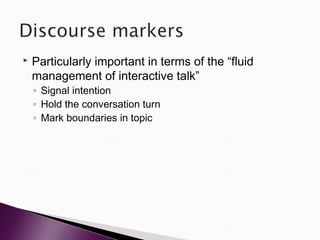The document contrasts spoken and written language, highlighting the distinct features of interactive spoken English such as context dependence, dialogic nature, and reliance on informal conversational skills. It emphasizes the importance of various skills including listening comprehension, conversation management, and sociocultural knowledge for effective communication. The document suggests instructional strategies that focus on awareness-raising, appropriation, and autonomy to address gaps in students' spoken language abilities.












